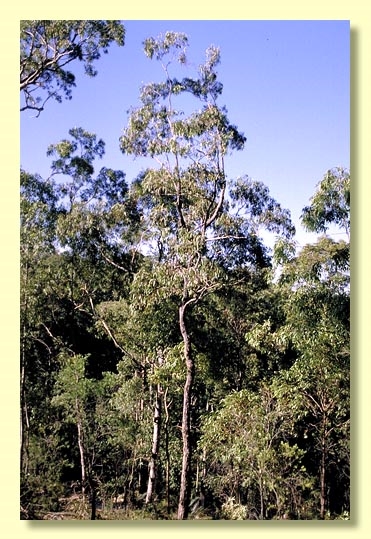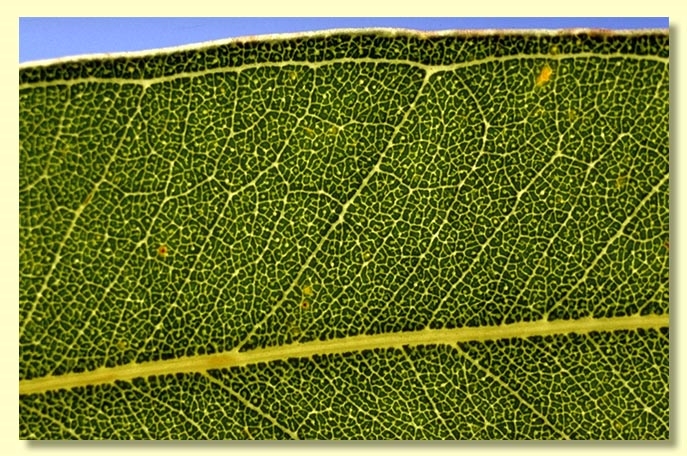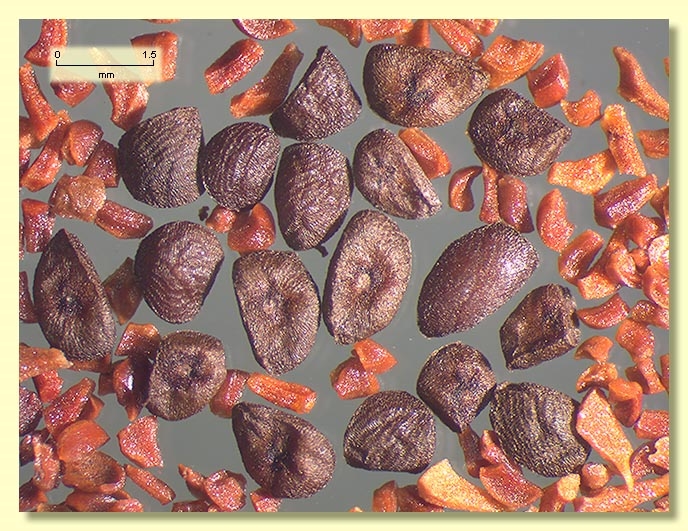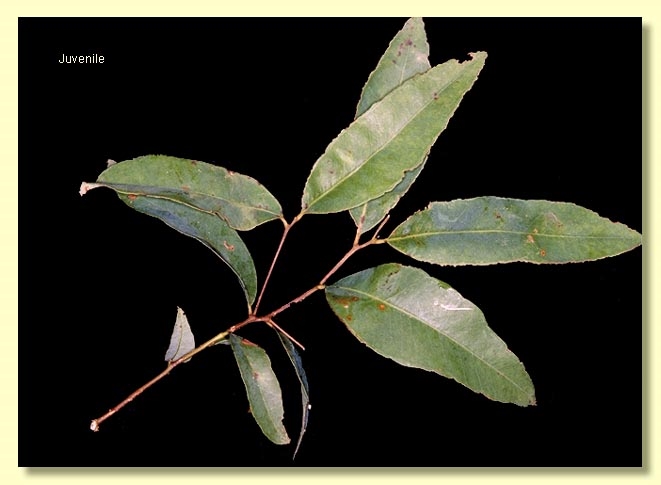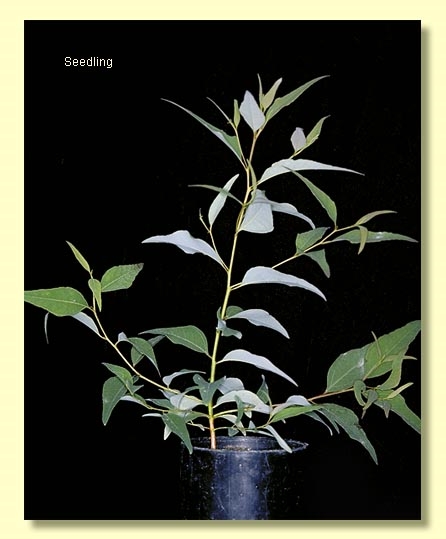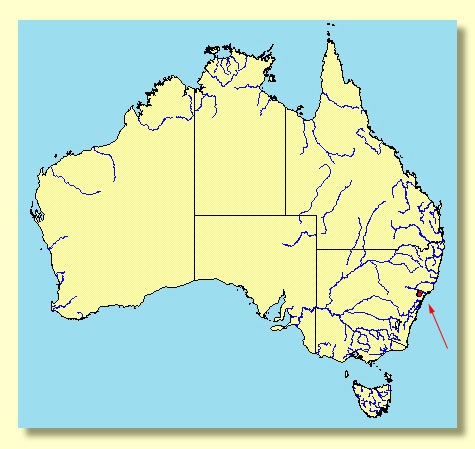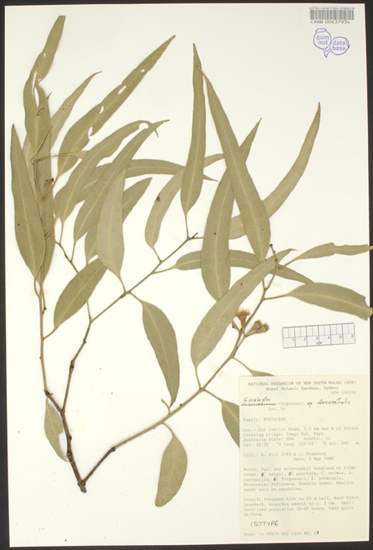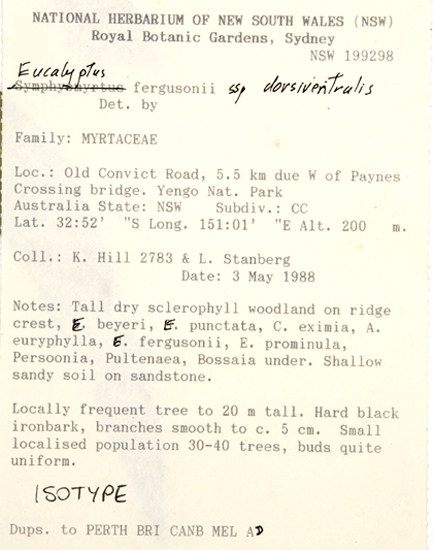Euclid - Online edition
Eucalyptus sp. Dorsiventralis
Eucalyptus | Symphyomyrtus | Adnataria | Terminales | Rhodoxyla | Discolores
Eucalyptus fergusonii R.T.Baker subsp. dorsiventralis L.A.S.Johnson & K.D.Hill, Telopea 4: 80(1990). T: NSW, North Coast, Old Convict Road, 5.5 km due W of Paynes Crossing bridge, 3 May 1988, K.D.Hill 2783 & L.Stanberg; holo: NSW; iso: AD, BRI, CANB, MEL, PERTH.
This taxon was referred to informally as E. Dorsiventralis in earlier editions of EUCLID.
Ironbark to the small branches, hard, grey or black.
Juvenile growth (coppice or field seedlings to 50 cm): stems square in cross-section; leaves alternate, ovate to lanceolate, 7.5–12 cm long, 2.5–4.5 cm wide, dull to glossy, green.
Adult leaves alternate, petiole 0.9–2.2 cm long; blade lanceolate, 8–16 cm long, 1.5–3.7 cm wide, base tapering to petiole, discolorous, glossy, green, side-veins greater than 45° to midrib, very densely reticulate, intramarginal vein parallel to and just within margin, oil glands intersectional or obscure.
Inflorescence terminal compound, peduncles 0.6–1.8 cm long, buds 7 per umbel, pedicels 0.7–1 cm long. Mature buds fusiform to obovoid, square in cross-section or with 4 prominent longitudinal ribs on hypanthium, 1–1.3 cm long, 0.6–0.7 cm wide, scar present, operculum conical to pyramidal, stamens inflexed, staminodes present, anthers cuboid, adnate, slits separate, style long, stigma pin-head shaped, locules 4 or 5, the placentae each with 4 vertical ovule rows.
Fruit pedicellate (pedicels 0.5–1.3 cm long), obconical or barrel-shaped, square in cross section, 0.9–1.3 cm long, 0.6–1 cm wide, always longer than wide, with 4 longitudinal ribs, disc descending, valves 4 or 5, enclosed.
Seeds dark brown, 1–2 mm long, flattened-ovoid, may be pointed at one end, dorsal surface shallowly reticulate, hilum ventral.
Cultivated seedlings (measured at ca node 10): cotyledons bilobed to oblong; stems square in cross-section, smooth; leaves petiolate, opposite for 5 or 6 nodes, then alternate, ovate to lanceolate, 5.5–7.5 cm long, 1.5–3 cm wide, base tapering, dull, green to blue-green.
Flowering has been recorded in May.
A tall ironbark tree of wetter sites in forests in Yengo National Park and Pokolbin State Forest north-west of Sydney, New South Wales. Characterised by the combination of distinctly discolorous glossy green adult leaves, terminal inflorescences, buds with inflexed stamens with an outer whorl of staminodes, fruit that are longer than wide, distinctly four-sided and relatively large to 1 cm wide with 4 or 5 valves, and ovate to broadly lanceolate juveniles.
Eucalyptus sp. Dorsiventralis is closely related to E. placita, E. decolor and E. paniculata, all four species having distinctly discolorous adult leaves and belonging to the subseries Discolores. Within this group, E. sp. Dorsiventralis differs from the other members by having slightly larger buds and fruit, with buds and fruit distinctly four-sided (buds and fruit in E. paniculata sometimes weakly four-sided; fruit in E. sp. Dorsiventralis 0.6–1 cm wide and 0.5–0.8 cm in E. paniculata, 0.4–0.6 cm in E. decolor and 0.5–0.7 cm in E. placita). E. placita differs further by having slightly broader, very glossy green juveniles leaves (up to 6 cm wide in E. placita and up to 4.5 cm wide in E. sp. Dorsiventralis). E. decolor differs further by having dull green adult leaves (glossy in E. sp. Dorsiventralis).
In New South Wales there are two other ironbarks with distinctly four-sided fruit: E. caleyi subsp. ovendenii and E. tetrapleura. They can be both separated from E. sp. Dorsiventralis by having dull concolorous adult leaves (distinctly discolorous and glossy in E. sp. Dorsiventralis). All other members of this subgroup have buds and fruit rounded in cross-section.
Within the ironbarks in general, there are only three other species that have buds and fruit square in cross-section: E. quadricostata, E. farinosa and E. shirleyi. All three are from North Queensland and should not be confused with E. sp. Dorsiventralis.
Eucalyptus sp. Dorsiventralis was originally described as a subspecies of E. fergusonii R.T. Baker, the latter being a poorly known species described in 1917 with the type coming from Buladelah, New South Wales. E. fergusonii subsp. fergusonii seems to be an obscure variant of the common and widespread E. paniculata, differing only in being strongly four-angled in the fruit. Johnson & Hill (1990) acknowledge that both E. paniculata and E. fergusonii subsp. fergusonii show "substantial interbreeding", and we have noted that degrees of ribbing of fruits occur in the Buladelah area with plants fairly typical of E. paniculata being commonly mixed with plants with obvious ribs. Hence we regard E. fergusonii subsp. fergusonii as an extreme form of E. paniculata. Eucalyptus sp. Dorsiventralis, on the other hand, whilst relatively rare, is easy to find and easily distinguished from E. paniculata by the combination of strongly four-angled fruit and fruit being noticeably longer than wide.

